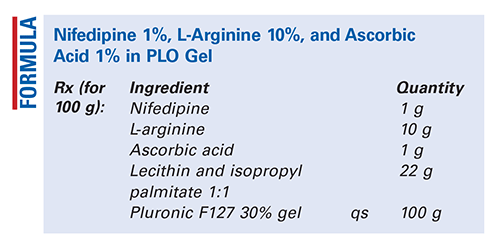US Pharm. 2022;47(11):58-59.

Method of Preparation: Note—Nifedipine is sensitive to light, so work in subdued light. Calculate the required quantity of each ingredient for the total amount to be prepared. Accurately weigh or measure each ingredient. Mix the nifedipine, L-arginine, and ascorbic acid. Add sufficient propylene glycol, mixing well to form a smooth paste. Incorporate the 1:1 mixture of lecithin and isopropyl palmitate; mix well. Add the Pluronic F127 30% gel and mix well, using a shear-mixing method, until uniform and smooth. Package and label.
Use: This preparation is used topically in the treatment of neuropathic pain involving the feet and foot ulcers caused by diabetes.1
Packaging: Package in tight, light-resistant containers.
Labeling: Keep out of reach of children. Discard after ____ [time period]. For external use only.
Stability: Check the state Board of Pharmacy requirements for the best-use date that can be used for this preparation.2
Quality Control: Quality-control assessment can include theoretical weight compared with actual weight, pH, specific gravity, active drug assay, color, texture–surface, texture–spatula spread, appearance, feel, rheologic properties, physical observations, and preservative-effectiveness test for creams and gels.3,4
Discussion: Diabetes can cause various conditions, including neuropathic pain, topical ulcers, erectile dysfunction, circulatory disorders, and others. This formula has been used in the treatment of neuropathic foot pain and foot ulcers.
Nifedipine has been used alone and in combination products to enhance circulation in areas of ischemia, particularly in the hands and feet. Nifedipine (Adalat, Procardia, C17H18N2O6, MW 346.33) is a 1,4-dihydropyridine–derivative calcium channel blocker. It occurs as a yellow powder that is affected by exposure to light. Nifedipine is practically insoluble in water and soluble in alcohol.1,5
L-arginine is an essential amino acid that has been used as a vasodilator. Arginine (C6H14N4O2, MW 174.20) occurs as white, practically odorless crystals that are freely soluble in water and sparingly soluble in alcohol.2,6
Ascorbic acid (L-ascorbic acid, vitamin C, C6H8O6, MW 176.12), an antioxidant, has been used to enhance the effect of L-arginine. It occurs as white or slightly yellow crystals or powder. When exposed to light, ascorbic acid gradually darkens. It is freely soluble in water (1:3) and sparingly soluble in alcohol (1:40).2,7,8
Lecithin (egg lecithin, soybean lecithin, vegetable lecithin) describes a complex mixture of phosphatidylcholine, phosphatidylethanolamine, phosphatidylserine, and phosphatidylinositol. It is used as an emollient, emulsifying agent, and solubilizing agent. Lecithin is practically insoluble in water, polar solvents, and cold vegetable and animal oils, and when mixed with water, it hydrates to form emulsions.9
Isopropyl palmitate (C19H38O2, MW 298.51) is a colorless, mobile liquid with a very slight odor. It is used as an emollient, oleaginous vehicle, and solvent. Isopropyl palmitate is soluble in acetone, castor oil, cottonseed oil, alcohol, and mineral oil. It is insoluble in water.10
The Pluronics (poloxamers) are a series of block copolymers of ethylene oxide and propylene oxide that are used as emulsifying agents, solubilizing agents, and wetting agents. They are available in different grades, either liquids or solids. Poloxamer 407 (Pluronic F127) is generally available in powdered form. It is freely soluble in water, alcohol, and isopropyl alcohol.11
REFERENCES
1. Gorman S. L-arginine and ascorbic acid for diabetic foot ulcers. IJPC. 2000;4(2):94-96.
2. U.S. Pharmacopeia/National Formulary [current revision]. Rockville, MD: U.S. Pharmacopeial Convention, Inc; October 2022.
3. Allen LV Jr. Summary of quality-control testing for sterile and nonsterile compounded preparations, part 1: physical and chemical testing. IJPC. 2019;23(3):211-216.
4. Allen LV Jr. Summary of quality-control testing for sterile and nonsterile compounded preparations, part 2: microbiological testing. IJPC. 2019;23(4):299-303.
5. Meece J. Five compounds for treating diabetes-related conditions. IJPC. 2003;7(3):170-173.
6. Foan ES. Arginine. In: Sheskey PJ, Hancock BC, Moss GP, Goldfarb DJ, eds. Handbook of Pharmaceutical Excipients. 9th ed. London, England: Pharmaceutical Press; 2020:113-114.
7. Kibbe AH. Ascorbic acid. In: Sheskey PJ, Hancock BC, Moss GP, Goldfarb DJ, eds. Handbook of Pharmaceutical Excipients. 9th ed. London, England: Pharmaceutical Press; 2020:116-119.
8. Gold ME, Wood KS, Byrns RE, et al. L-arginine-dependent vascular smooth nuscle relaxation and cGMP formation. Am J Physiol. 1990;259(6 Pt 2):H1813-H1821.
9. Shah HC, Singh KK, Gavankar T, Kedia A. Lecithin. In: Sheskey PJ, Hancock BC, Moss GP, Goldfarb DJ, eds. Handbook of Pharmaceutical Excipients. 9th ed. London, England: Pharmaceutical Press; 2020:599-602.
10. Quinn ME. Isopropyl palmitate. In: Sheskey PJ, Hancock BC, Moss GP, Goldfarb DJ, eds. Handbook of Pharmaceutical Excipients. 9th ed. London, England: Pharmaceutical Press; 2020:557-559.
11. Khorsand B, Alvarez-Nunez F. Poloxamer. In: Sheskey PJ, Hancock BC, Moss GP, Goldfarb DJ, eds. Handbook of Pharmaceutical Excipients. 9th ed. London, England: Pharmaceutical Press; 2020:756-761.
The content contained in this article is for informational purposes only. The content is not intended to be a substitute for professional advice. Reliance on any information provided in this article is solely at your own risk.
To comment on this article, contact rdavidson@uspharmacist.com.





